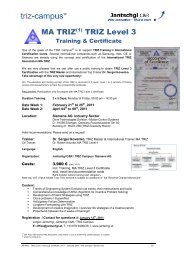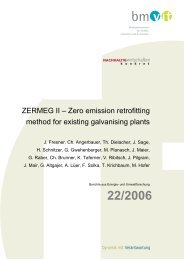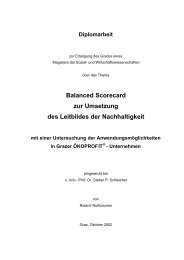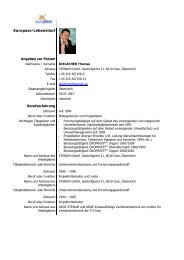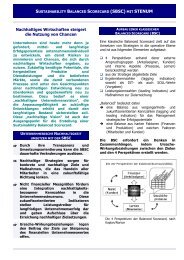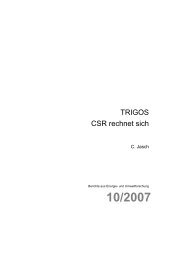Promoting Resource Efficiency in Small & Medium size ... - UNEP
Promoting Resource Efficiency in Small & Medium size ... - UNEP
Promoting Resource Efficiency in Small & Medium size ... - UNEP
Create successful ePaper yourself
Turn your PDF publications into a flip-book with our unique Google optimized e-Paper software.
• Separate storage of substances that can be ext<strong>in</strong>guished with<br />
water and substances that cannot be ext<strong>in</strong>guished with water<br />
Chemicals that can be ext<strong>in</strong>guished with water should be<br />
separated from chemicals that must not be ext<strong>in</strong>guished with<br />
water. Wherever possible, store these two groups of substances<br />
<strong>in</strong> different rooms.<br />
• No storage of chemicals at the workplace<br />
Often large amounts of hazardous substances are (temporarily)<br />
stored at the workplace (e.g. solvent conta<strong>in</strong>ers under worktops).<br />
In case of an accident these substances are a major source of<br />
danger. Do not keep more than one day’s requirement of any<br />
hazardous substance at the workplace. Refill daily from the<br />
central storage po<strong>in</strong>t.<br />
• Keep<strong>in</strong>g storage records<br />
At each storage po<strong>in</strong>t, the company must keep a storage list.<br />
The list should <strong>in</strong>clude the type, quantity and risk potential of<br />
the stored substance. If an accident occurs, the fire brigade will<br />
know how to fight the fire due to the <strong>in</strong>formation provided by the<br />
storage list.<br />
• Substitution of high risk substances<br />
The best way of avoid<strong>in</strong>g risks associated with the storage of<br />
chemicals is to elim<strong>in</strong>ate high-risk substances altogether from<br />
the company and replace them by less dangerous alternatives.<br />
In particular, substances with a high potential to cause a fire or<br />
damage to human health or the environment (e.g. chlor<strong>in</strong>ated<br />
hydrocarbons, products conta<strong>in</strong><strong>in</strong>g heavy metals and watersoluble<br />
substances that will not readily degrade, such as nondegradable<br />
surfactants) should be substituted.<br />
8.4 CHECKLIST: chemical management<br />
The follow<strong>in</strong>g checklists provide a list of options to reduce the<br />
consumption of chemicals <strong>in</strong> the domestic area, offices, for the storage<br />
of chemicals as well as guidel<strong>in</strong>es for the substitution of commonly<br />
used hazardous process chemicals. These options can also be taken<br />
as generic approaches to look for opportunities to reduce the hazards<br />
associated with chemicals <strong>in</strong> production sites.<br />
8.4.1 Domestic chemicals<br />
• Automate detergent dispens<strong>in</strong>g to avoid accidental manual overdos<strong>in</strong>g<br />
• Empty chemical dos<strong>in</strong>g drums completely, dra<strong>in</strong> any residue<br />
<strong>in</strong>to the new drum<br />
• Use of low-temperature detergents reduces energy costs, may<br />
r<strong>in</strong>se more easily, reduce the risk of colour run and reta<strong>in</strong> better<br />
colour brightness<br />
• Check dispens<strong>in</strong>g <strong>in</strong>structions and measure detergents<br />
• Set chemical dos<strong>in</strong>g pumps for low, medium and high dip<br />
washes<br />
• Check <strong>in</strong>-use detergent strengths, where possible<br />
8.4.2 Office chemicals<br />
• Reduce the number and volume of chemical products <strong>in</strong> use,<br />
especially for clean<strong>in</strong>g<br />
• Inquire as to an updated safety data sheets (SDS) with each reorder<br />
and file updated SDS with the security adm<strong>in</strong>istrator or<br />
purchas<strong>in</strong>g department<br />
• Return the SDS to the supplier or ask for a new one if:<br />
- The product identification does not correspond to the product<br />
- The SDS or parts of it are illegible<br />
- Date, manufacturer, distributor or product name are miss<strong>in</strong>g<br />
on the SDS<br />
- The <strong>in</strong>formation on the SDS does not correspond to the<br />
product identification<br />
- The SDS is not subdivided <strong>in</strong>to the required 16 chapters<br />
• Contact the supplier if:<br />
- The SDS is not up-to-date<br />
- The classification accord<strong>in</strong>g to the chemical’s regulation is<br />
miss<strong>in</strong>g, <strong>in</strong>complete or <strong>in</strong>correct<br />
- Part of the <strong>in</strong>formation is miss<strong>in</strong>g (e.g. environmental<br />
properties, disposal details)<br />
• Substitute high-risk hazardous substances with less dangerous<br />
alternatives<br />
• Elim<strong>in</strong>ate CMR (carc<strong>in</strong>ogenic, mutagenic, reprotoxic)<br />
substances as much as possible<br />
• Use automated systems to apply hazardous chemical<br />
substances<br />
• Segregate combustible and flammable hazardous chemical<br />
substances from each other<br />
• Measure and monitor concentrations of hazardous chemical<br />
substances<br />
• Install appropriate collective protection equipment<br />
• Distribute necessary personal protective equipment to the<br />
workers<br />
• Cont<strong>in</strong>uous local exhaust ventilation at all workplaces where the<br />
concentration of chemical substances exceeds the maximum<br />
admissible concentration<br />
• Regular technical checks of the equipment used with chemicals<br />
• Inspect and clean exhaust ventilation systems on a regular basis<br />
to ma<strong>in</strong>ta<strong>in</strong> maximum efficiency<br />
• Regular medical exam<strong>in</strong>ations for workers exposed to hazardous<br />
chemical substances, especially to CMR substances and<br />
substances with a biological limit value<br />
• Use of ventilation and monitor<strong>in</strong>g of concentrations<br />
• Prevention or elim<strong>in</strong>ation of ignition sources<br />
• Separation of substances that can form explosive mixtures with<br />
air from open flames, electrical equipment, sparks, etc.<br />
• Avoid contam<strong>in</strong>ation of orig<strong>in</strong>al conta<strong>in</strong>ers caused by pour<strong>in</strong>g<br />
back <strong>in</strong>to them the products they conta<strong>in</strong>ed<br />
• Clearly mark explosive areas<br />
• Clearly <strong>in</strong>dicate escape and rescue routes and keep those routes<br />
free of obstacles<br />
8.4.3 Storage of chemicals<br />
The follow<strong>in</strong>g strategies are re-pr<strong>in</strong>ted from “Guidel<strong>in</strong>es for the safe<br />
storage of chemicals” 2007 (University of Queensland, Australia):<br />
The quantities of hazardous chemicals should be kept to a m<strong>in</strong>imum,<br />
commensurate with their usage and shelf life. Some chemicals degrade<br />
<strong>in</strong> storage and can become more hazardous, e.g. chloroform can<br />
produce phosgene from prolonged storage. Such chemicals should<br />
be identified and managed appropriately. Schools are encouraged to<br />
develop centralised chemical purchas<strong>in</strong>g policies and monitor<strong>in</strong>g<br />
systems to m<strong>in</strong>imise stockhold<strong>in</strong>g.<br />
Ensure chemical conta<strong>in</strong>ers and their seals or stoppers are appropriate<br />
for the type and quantity of chemical stored. As far as is practicable,<br />
chemicals should be stored <strong>in</strong> the conta<strong>in</strong>ers <strong>in</strong> which they are supplied.<br />
If you repack chemicals make sure the new conta<strong>in</strong>ers are labelled<br />
properly. All packages <strong>in</strong> storage should be labelled to allow<br />
unmistakable identification of the contents and all labels should comply<br />
with the relevant regulations. Labels should be reattached or replaced,<br />
as necessary, to clearly identify the contents of the package.<br />
Conta<strong>in</strong>ers that have held hazardous chemicals should be treated as<br />
full, unless the receptacle or package has been rendered free from<br />
hazardous chemicals. Do not give away empty conta<strong>in</strong>ers to workers,<br />
86



